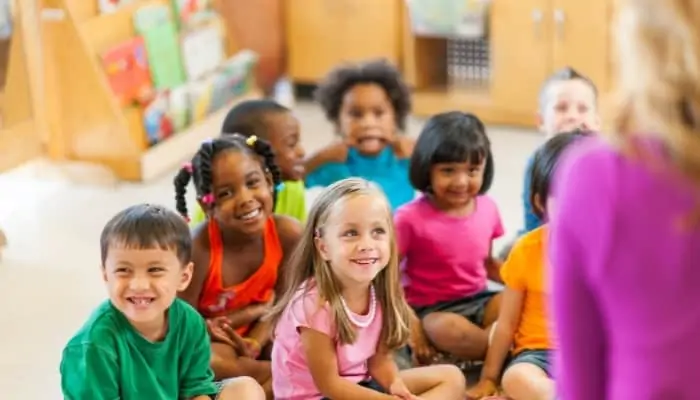Preschool vs Pre-K: Similarities and Differences

This post may contain affiliate links. If you buy through the link, I may earn a commission. Learn More.
I was chatting with a friend about pre-school options. She wondered why some places refer to themselves as “pre-schools,” and others use the term “pre-K.”
She said it’s needlessly confusing because pre-school and pre-K are the same thing. That’s when I realized many parents might not know the difference.
What’s the difference between pre-k and preschool?
Pre-school and Pre-K (pre-kindergarten) are similar, but not the same. Pre-school refers to a program that teaches the basics for children ages three to five. Pre-K focuses on kindergarten readiness for children who will be starting kindergarten within the next year.
*FYI, some of the links in this article about differences between pre-k vs. preschool may be affiliate links. If you click and make a purchase, we may get a commission (at no extra cost to you). For more info, please see our disclaimer.
Early Childhood Learning: Pre-School vs. Pre-K
So you’re a parent who has a child who’s not yet school-aged. Do you choose pre-school or pre-K for their early childhood learning needs? Luckily, this choice is a pretty easy one.
Pre-school: What it is and Why You Need it

Pre-school could be considered a bridge between daycare and school. Children are taught a variety of lessons that are practical, social, and emotional.
Pre-schools provide learning activities where children are given early access to letters, letter sounds, shape recognition, colors, and counting.
Some pre-schools offer additional curriculum. They may provide second language learning, musical skills, gardening, or faith-based activities.
In addition to structured learning, a great deal of a preschool program focuses on social skills. Children learn how to get along with one another, how to manage their emotions, and the importance of teamwork.
Children are nurtured at pre-school in a way similar to a daycare environment. They’re given plenty of breaks for outdoor recess, reading, napping, arts and crafts, pretend play, and more.
While there is structure in a pre-school, it’s not as rigid as elementary school or even pre-K.
Most pre-schools enroll children beginning at age three and accept them through age five. Some pre-schools might let children in earlier than age three if they’re already potty trained. However, most pre-schools will not accept children who are still in diapers.
Pre-K: The Importance of Pre-Kindergarten

Pre-Kindergarten usually referred to as pre-K, takes place the year before a child is to enroll in a kindergarten class. Pre-K offers school readiness by providing children with the skills they need to take on a full day of learning.
Pre-K has a fairly strict schedule. Children are expected to take part in learning activities throughout the day. They are given breaks for naps, snacks, and playtime, but they have a more rigorous schedule than they would have in pre-school.
The curriculum varies from school-to-school, but the learning at pre-K might include identifying letters and numbers, the practice of holding writing instruments, understanding measurements, and scientific discoveries.
Arguably most important is learning how to manage being in a classroom setting. Children who attend pre-K are taught how to ask for permission to use the restroom, the importance of adhering to a schedule and why listening is a vital skill.
Children are eligible for pre-K the year before they begin kindergarten. Most children attend pre-K beginning at age four and only stay in the program for one year.
However, there may be times when a second year of pre-K is appropriate before enrolling in kindergarten.
Why Not Choose Both?
| Preschool | Pre-K |
|---|---|
| For ages 3 – 5 | For ages 4 – 5 |
| A bridge between daycare and school | Prepares the child for all day learning |
Choosing between pre-school and pre-K is not an either/or proposition. Young children greatly benefit from pre-school. Likewise, those who are nearing kindergarten find tremendous growth in pre-K.
Therefore, you can choose to place your child in pre-school at age three and then move up to pre-K the following year. In fact, many early education institutions offer this natural progression as part of their program.
My children attended a school that did exactly that. At age three, the children entered a pre-school program. The following year, they moved up to pre-K.
It was ideal because we didn’t have to find a new school for pre-K, and our children didn’t have to get used to going to a new place when they already felt at home in their pre-school environment.
How to Find the Best Pre-School / Pre-K
Start by asking friends and neighbors who you trust. The odds are pretty good there will be a consensus in your community regarding the best options.
As soon as you have the names of a few pre-schools, do some research online. Find out their hours, what certification the staff has, and the cost. This should narrow your options down.
Your next step is to tour the facility. Meet the director and any teachers. If possible, schedule a tour while school is in session so you can see if the children seem happy or anxious. A meeting with the pre-school or pre-K director should help you make an informed and excellent choice.
Once you do make a choice, make a commitment. The best pre-schools often have long waitlists.
That was certainly true in my area. The school my children attended was so popular they recommended children be placed on the waitlist at least three years in advance.
It’s true!
The first call I made when I was home from the hospital after giving birth was not to my mother but to the pre-school. My second child was on the waitlist before she was born.
Does that seem a bit ridiculous? It might be. However, it’s reality.
If You Can Pick Both!
Pre-school and pre-K are not the same, but they’re both important. For many families, the best situation is a facility that offers both options at the appropriate times.
Have you looked into pre-schools yet? What have you found? Tell us about it in the comments!
